Atlanta inflata
Atlanta inflata
Roger R. SeapyIntroduction
Atlanta inflata is a small species; shell diameter less than about 1.5 mm. The shell is transparent, although the spire is either brown to reddish-brown or violet to light purple due to the coloration of underlying tissues. The spire sutures are clear, lacking coloration. The keel is tall with a truncate leading edge and has a yellowish-brown to brown base. Because of the small maximal shell size, the keel never inserts between the penultimate and last shell whorls. The shell spire is low conical and consists of 4-1/4 to 4-1/2 whorls. The spire whorls possess spiral ridge sculpture that ranges from weakly to strongly developed. Eyes type a, operculum type c, and radula type I. Most of its morphological characters are shared with A. selvagensis, but A. inflata has one fewer spire whorls and has clear spire sutures. Its geographic distribution is limited to the Pacific Ocean in tropical to subtropical waters. Although reported as rare in waters off western Australia and New Guinea, it recorded as abundant in Hawaiian waters.
Diagnosis
- Maximal shell diameter <1.5 mm
- Keel tall, with a truncate leading edge
- Keel base yellowish-brown to brown
- Keel does not insert between penultimate and last shell whorls
- Shell spire consists of 4-1/4 to 4-1/2 whorls
- Spire whorls with evenly-spaced spiral ridges, ranging from weakly to strongly developed
- Spire sutures shallow and clear (unpigmented)
- Spire coloration either brown to reddish-brown or violet to light purple
- Eyes type a
- Operculum type c
- Radula type I
Characteristics
- Shell
- Maximal diameter of shell 1.5 mm in Hawaiian (Seapy, 1990a) and eastern Australian (Newman, 1990) waters, although one of the syntypes of Souleyet (1852) from the tropical western Pacific measured 1.8 mm (Janssen and Seapy, 2009)
- Shell transparent, except for the yellowish-brown to brown keel base (see title illustration)
- Keel tall, with a truncate leading edge
- Keel extends around most of the shell's circumference in large adults, but extends far enough to insert between the penultimate and last whorls
- Spire shape low conical, consisting of 4-1/4 to 4-1/2 whorls
- Spire whorls with evenly-spaced spiral ridges that range in Hawaiian waters from moderately developed (between whorls 1-1/2 and 3-1/4; see third to last SEM below) to strongly developed (beginning at the end of the first whorl and ending at whorl 4-1/2; see third SEM below). In waters off eastern Australia spiral ridge development ranges more broadly, from strongly to weakly developed (Newman, 1990). An example of the latter condition was shown by Newman in low and high magnification SEMs of a shell with a single spiral ridge on the second to fourth whorls; however, the precise location where the spiral ridge began and ended could not be determined because of the steep angle of the tilted shell in the SEMs)
 Click on an image to view larger version & data in a new window
Click on an image to view larger version & data in a new window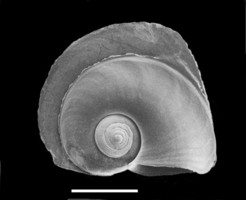
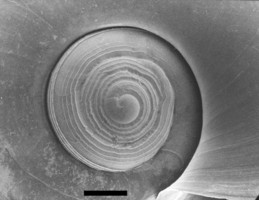
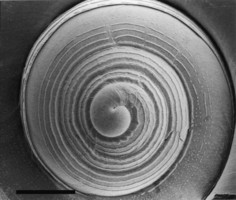
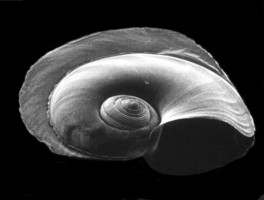
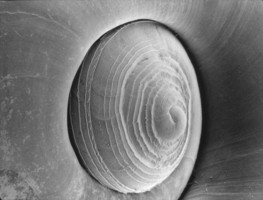
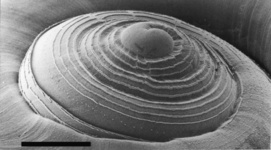
Figure. Scanning electron micrographs of Atlanta inflata shells, viewed from the right side (above) and at about a 60° tilt (below). In each series, views are of the whole shell (left) and the shell spire (middle and right). The left and middle SEMs are of a 1.2 mm shell and the right ones are of a 0.9 mm shell. Scale bars in upper photographs = 0.5 mm (left) and 0.1 mm (middle and right). © Roger R. Seapy

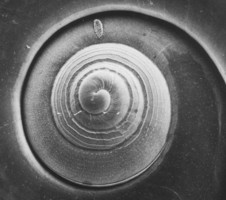
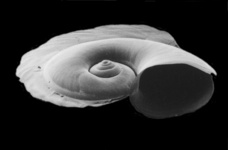
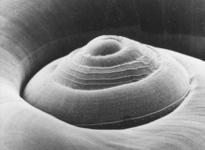
Figure.Scanning electron micrographs of a 1.5 mm Atlanta inflata shell, viewed from the right side (above) and at a 60° tilt (below) at low (left) and high (right) magnifications, respectively. ©
- Spire sutures clear, lacking pigmentation
- In apertural view the dorsal and ventral halves of the shell are separated between the shell aperture and keel origin, forming a broad-based, wedge-like slit
 Click on an image to view larger version & data in a new window
Click on an image to view larger version & data in a new window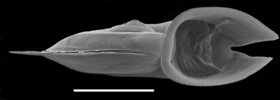
Figure. Scanning electron micrograph of Atlanta inflata in apertural view. Shell diameter (excluding keel) = 1.5 mm. Note the broad-based slit beginning at the shell aperture (right side of photograph). Note also the accurate rendition (due to the exact horizontal orientation of the shell) of the low conical spire shape. Scale bar = 0.5 mm. © 2006 Daniel Geiger
- Two spire color morphs (Seapy, 1990a; also reported by Tesch, 1906, based on observations of specimens collected during the Siboga Expedition in the western tropical Pacific); either brown to reddish-brown (see photograph below) or violet to light purple (see title illustration)
- Maximal diameter of shell 1.5 mm in Hawaiian (Seapy, 1990a) and eastern Australian (Newman, 1990) waters, although one of the syntypes of Souleyet (1852) from the tropical western Pacific measured 1.8 mm (Janssen and Seapy, 2009)
- Eyes type a; lacking a transverse slit in the distal pigmented tissue
- In Hawaiian specimens, the distal pigmented tissue is indented medially, forming a characteristic broad "V" shape (see photograph below)
- In Hawaiian specimens, the distal pigmented tissue is indented medially, forming a characteristic broad "V" shape (see photograph below)
- Operculum type c (monogyre)
- Radula type I
Comments
Taxonomy: Recent examination of the historical record preceding the description of Atlanta inflata by Souleyet in 1852 has revealed that priority for this species must be given to J. E. Gray, who latinized the French vernacular name 'Atlante renflée', as published first by Eydoux and Souleyet in 1841 and then by Souleyet in his 1852 Bonite Expedition Report chapter (discussed in Janssen and Seapy, 2009).
Since the revision of the genus Atlanta by Tesch (1908), A. inflata has been regarded universally as a cosmopolitan species; found in all three of the major oceans at tropical to subtropical latitudes. The validity of the species in the Atlantic and Indian Oceans, however, was rejected by Janssen and Seapy (2009), who showed that Atlanta selvagensis, described by de Vera and Seapy (2006) from the tropical eastern Atlantic, is in full agreement with specimens previously identified as A. inflata from the Atlantic and Indian Oceans. For further details, see the Atlanta selvagensis page.
Included in the original description of Atlanta inflata by Souleyet (1852) was a colorized drawing (Plate 19, Fig. 21) of an adult specimen extended from its shell (reproduced below based on a color transparency of the plate provided by Arie Janssen). The figure was scanned and the spire enlarged to reveal detail of the spire whorls. In the second image the whorl sutures have been highlighted to enable determination of the number of whorls (about 4-1/4) comprising the spire

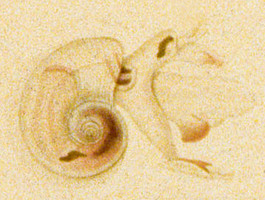
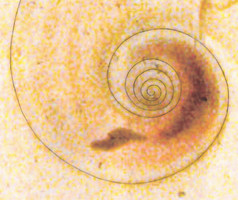
Figure. Drawing of an adult male Atlanta inflata (from Souleyet, 1852, Plate 19, Fig. 21), with the body extended from the shell (left). The spire region of the shell is enlarged (right) and the whorl sutures highlighted. © L. F. A. Souleyet 1852
In his 1852 descriptions of A. inflata and A. helicinoidea (based on specimens collected from the tropical western Pacific Ocean), Souleyet commented on the strong similarities between the two species. Subsequent authors have also remarked about the similarity of the shells in the two species, which was addressed in a side-by-side comparison of the two by Richter (1987). Because both species are small with a nearly identical spire of about 4-1/2 whorls, the shells are very similar. However, the variability in expression of the spiral ridge sculpture in A. inflata (discussed above) contrasts with a lack of variation in A. helicinoidea (see A. helicinoidea page). Also, Seapy (1990a) noted that the spiral ridges in Hawaiian A. helicinoidea were thinner and less elevated than in A. inflata, with the result that the spire whorls are more clearly defined in A. helicinoidea. More prominently, the keel is markedly different in the two species; in A. helicinoidea it is low and rounded with a slanting, corrugated texture (see the A. helicinoidea page), while in A. inflata it is tall with a truncate leading edge and the surface is smooth (see title illustration and first SEM above). Lastly, if the soft parts are available for examination, the two species are immediately distinguished by the eyes which are type a in A. inflata and type c in A. helicinoidea.
Ecology: Atlanta inflata was found to be abundant in Hawaiian waters (Seapy, 1990a, 2008). It ranked fourth among thirteen atlantid species in the former study, accounting for 14% of the total species counts. In the latter study (Seapy, 1008) it was third among thirteen species during fall and spring sampling periods, accounting for 13.3% and 13.6%, respectively, of total mean nighttime species abundances.
Diel vertical distribution of Atlanta inflata was investigated in two studies (Seapy, 1990b and 2008). In the first paper it was recorded from the surface to 145 m during the day and showed a limited migration into the upper 90 m at night, with a maximal mean density of 9.5 individuals per 1,000 m3 in the 45-90 m depth interval during the day. In the 2008 study mean nighttime abundances decreased from oceanic (15 nmi) to neritic (1 nmi) waters by 70% (fall) and 40% (spring), respectively. Evidence for nocturnal vertical migration was weak to nonexistent except at the 5 and 15 nmi stations, but at the 1 nmi station during the spring densities were higher at depths below 30 m during the day and above 30 m at night.
References
Gray, J. E. 1850. Explanation to the plates. In: Gray, M. E., Figures of molluscous animals selected from various authors, etched for the use of students. Vol. 4, 124 pp. Longman, Brown, Green and Longmans, London.
Janssen, A. W. and R. R. Seapy. 2009b. On the identity and distribution of Atlanta inflata Gray, 1850 (Gastropoda, Pterotracheoidea, Atlantidae) in the world's oceans. Basteria 73: 139-157.
Richter, G. 1987. Zur Kenntnis der Gattung Atlanta (III), Atlanta inflata, A. helicinoides, A. echinogyra und A. plana (Prosobranchia: Heteropoda). Archiv fur Mollusken-Kunde 117: 177-201.
Seapy, R. R. 1990a. The pelagic family Atlantidae (Gastropoda, Heteropoda) from Hawaiian waters: a faunistic survey. Malacologia 32(1): 107-130.
Seapy, R. R. 1990b. Patterns of vertical distribution in eipelagic heteropod molluscs off Hawaii. Marine Ecology Progress Series 60: 235-246.
Seapy, R. R. 2008. Offshore-inshore and vertical distributional patterns of heteropod mollusks off leeward Oahu, Hawaii. Marine Biology 154: 985-995.
Souleyet, [L. F. A.]. 1852. In: Eydoux, [F.] and Souleyet [L. F. A.], Voyage autour du monde execute pendant les annees 1836 et 1837 sur la corvette 'La Bonite'... Zoologie, col. 2. 664 pp. A. Bertrand, Paris.
Tesch, J. J. 1906. Die Heteropoden der Siboga-Expeditie. Monographie 51, 112 pp. E. J. Brill, Leiden.
Title Illustrations

| Scientific Name | Atlanta inflata |
|---|---|
| Location | Hawaiian waters |
| Specimen Condition | Live Specimen |
| Sex | Male |
| Life Cycle Stage | adult |
| View | right side |
| Image Use |
 This media file is licensed under the Creative Commons Attribution-NonCommercial License - Version 3.0. This media file is licensed under the Creative Commons Attribution-NonCommercial License - Version 3.0.
|
| Copyright |
©

|
About This Page

California State University, Fullerton, California, USA
Correspondence regarding this page should be directed to Roger R. Seapy at
Page copyright © 2012
 Page: Tree of Life
Atlanta inflata . Atlanta inflata .
Authored by
Roger R. Seapy.
The TEXT of this page is licensed under the
Creative Commons Attribution License - Version 3.0. Note that images and other media
featured on this page are each governed by their own license, and they may or may not be available
for reuse. Click on an image or a media link to access the media data window, which provides the
relevant licensing information. For the general terms and conditions of ToL material reuse and
redistribution, please see the Tree of Life Copyright
Policies.
Page: Tree of Life
Atlanta inflata . Atlanta inflata .
Authored by
Roger R. Seapy.
The TEXT of this page is licensed under the
Creative Commons Attribution License - Version 3.0. Note that images and other media
featured on this page are each governed by their own license, and they may or may not be available
for reuse. Click on an image or a media link to access the media data window, which provides the
relevant licensing information. For the general terms and conditions of ToL material reuse and
redistribution, please see the Tree of Life Copyright
Policies.
- First online 12 January 2010
- Content changed 30 January 2012
Citing this page:
Seapy, Roger R. 2012. Atlanta inflata . Atlanta inflata . Version 30 January 2012 (under construction). http://tolweb.org/Atlanta_inflata/28764/2012.01.30 in The Tree of Life Web Project, http://tolweb.org/




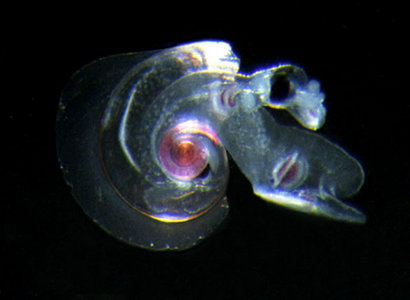
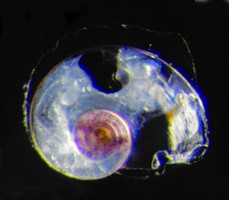
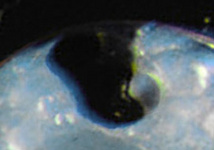
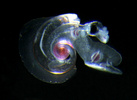


 Go to quick links
Go to quick search
Go to navigation for this section of the ToL site
Go to detailed links for the ToL site
Go to quick links
Go to quick search
Go to navigation for this section of the ToL site
Go to detailed links for the ToL site